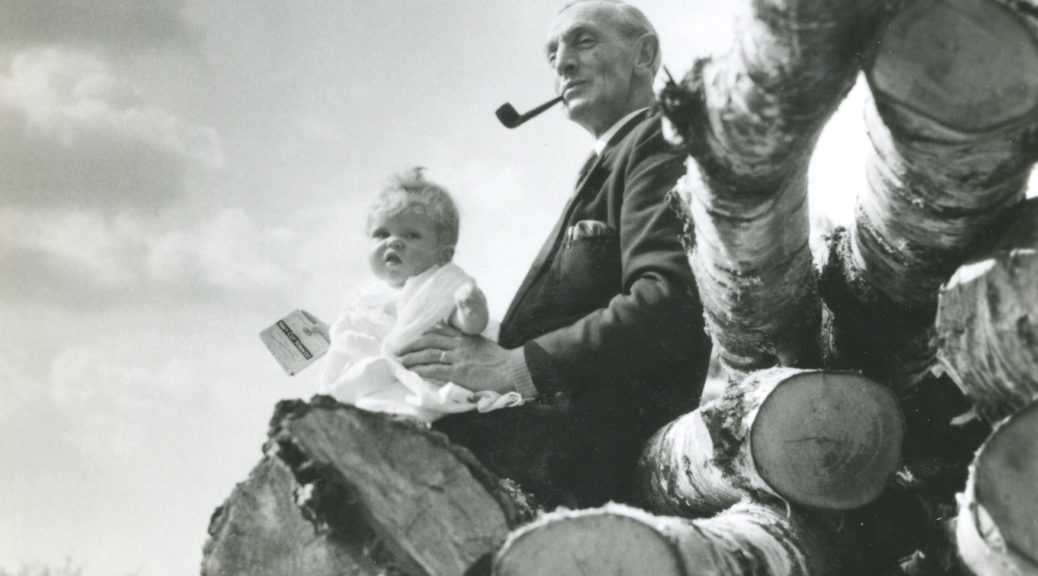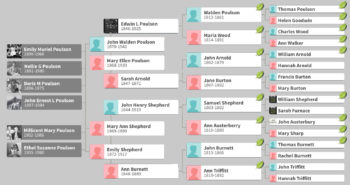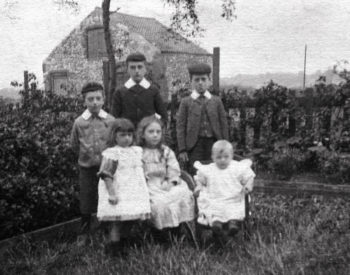
My grandfather was very much of his generation – fought in WWI, wore a jacket and tie on country walks with his dog, said things like “if a thing’s worth doing, it’s worth doing well” and tried to part my hair on the right (it parts on the left) because he had the idea that boys’ hair parts on the left and girls’ on the right – like shirt buttons, but not exactly! Politically he was pretty conservative – used to rail against trade unions until I told him I was joining the National Union of Students (it was mandatory at the time) when I went to university. “I’m sure you’ll straighten them out, darling” was how he reconciled that clash.
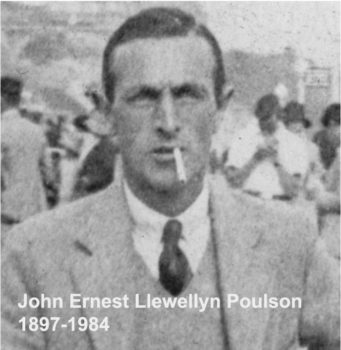 This is Honest John the bank manager, John Ernest Llewellyn Poulson, son of Wastrel John Walden Poulson, born in Knottingley, Yorkshire in 1897. He was his parents’ fourth child and first son. Less than two years after he was born, a common occurrence of this time affected his family – his mother Mary Ann died in childbirth, aged 29. Her daughter, Mary Sybil, lived just past her first birthday. Then she died of broncho-pneumonia. Even with the limited understanding of death at age three, this can’t have been easy for young John.
This is Honest John the bank manager, John Ernest Llewellyn Poulson, son of Wastrel John Walden Poulson, born in Knottingley, Yorkshire in 1897. He was his parents’ fourth child and first son. Less than two years after he was born, a common occurrence of this time affected his family – his mother Mary Ann died in childbirth, aged 29. Her daughter, Mary Sybil, lived just past her first birthday. Then she died of broncho-pneumonia. Even with the limited understanding of death at age three, this can’t have been easy for young John.
To me, he was Gamps.
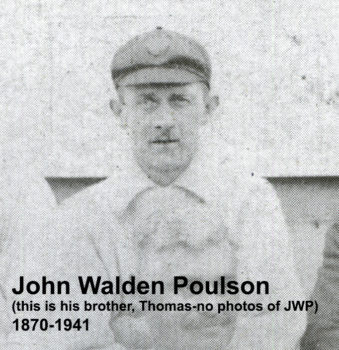 Wastrel John Walden was the first son of Upstanding Edwin – his son and heir as it were – and had himself lost his mother Sarah when nearly two – she was only 24. In both cases, a second marriage provided a stepmother – Upstanding Edwin married Emily (and had two more sons); Wastrel John Walden married Emily and also had two more daughters. Those details may be the only similarities between Wastrel John and his Dad! It made for a lot of Emily Poulsons though – the two wives plus Wastrel John’s first daughter was named Emily (my great aunt, known as Aunty Poul (say POLE) to us.
Wastrel John Walden was the first son of Upstanding Edwin – his son and heir as it were – and had himself lost his mother Sarah when nearly two – she was only 24. In both cases, a second marriage provided a stepmother – Upstanding Edwin married Emily (and had two more sons); Wastrel John Walden married Emily and also had two more daughters. Those details may be the only similarities between Wastrel John and his Dad! It made for a lot of Emily Poulsons though – the two wives plus Wastrel John’s first daughter was named Emily (my great aunt, known as Aunty Poul (say POLE) to us.
I’ll tell the details of how Wastrel John abandoned his family in another post, along with the juicy tid bits of his first two marriages – they are you-can’t-make-this-stuff-up stories. For now it’s enough to say that Gamps was 13 when his Dad took off leaving behind 6 children between the ages of 20 and 5. It was fortunate that the family was comfortably off (no thanks to The Wastrel) so as far as I know, no one went hungry.
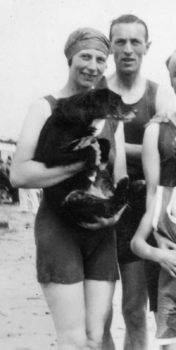
Gamps’ two oldest sisters, Emily and Gwen, were close to adulthood and on their way to being a school teacher and a nurse, but Gamps and his favorite sister, Goggie, 14, (she was Doris Marguerite on paper) needed somewhere to go and their Aunt, Wastrel John’s older sister, Mary Ellen, took them both in. She was by then married to a solicitor, Theophilus Wood, so that meant a move to Portsmouth in Hampshire, a world away from Knottingley. Other than one visit in 1924 after Gamps and my grandmother were married, he never returned to Yorkshire.
Gamps’ two youngest sisters (Emily’s children) went to live with their maternal grandparents – Emily’s Dad, John Henry Shepherd, with his second wife (Emily’s mother had died many years earlier). John Henry is another colorful character – sometime horse dealer and ran a pub/inn in Ferrybridge . When his first wife died, 3 months later, he married again, moved into the Red Lion Hotel (as manager) and left his youngest children (9 & 13) in the care of two of his daughters (18 & 19) – who also had to manage two boarders!
In 1910, when the Wastrel John Walden took off, whatever sense of family Gamps previously had was fragmented – at this point his sister Goggie and his Aunt Mary are it. He’s a long way from any friends he’d made in Yorkshire, although at least he knew his cousin Edwin (Aunt Mary’s son) – the picture at the top was a postcard Edwin sent home to his Mum when he visited the Yorkshire relatives in 1904. Three cheers for Aunt Mary, but what a tough time for Gamps. It all got worse not long after, but that’s yet another story of Aunt Mary’s husband and his family tangles. Then World War I loomed and unstable family was the least of anyone’s problems.
In looking through my Dad’s “Progress Book”, he had two aunts with whom he regularly spent time – with Goggie (Gamps’ sister) and Sis (Nanny’s sister). When Jill was born he went to Goggie; when Nanny had the flu he went to Sis for 3 weeks; when they moved from Chichester to Bournemouth, both kids stayed with Goggie for 2 weeks. Later on, half-term holidays from boarding school were sometimes spent with Goggie or Sis & Ernie.
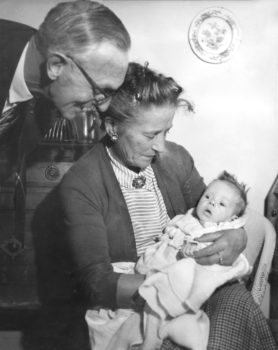
Fast forward to October 1954 and the birth of Gamps’ first grandchild – me. My Mum had post-partum psychosis and was in hospital. Less than a month before I was born, my Dad and another actor (my godfather Peter Goss) signed a lease on the New Theatre, Bromley and were working hard to get the business running (first play opened in March 1955).
In addition to being preoccupied, my Dad knew nothing about babies – when I wouldn’t stop crying even though he’d tried to feed me a bottle, he called his Aunt Goggie (who had become a registered nurse in Portsmouth) to ask what to do. After a few questions, she asked if he’d pierced the teat on the bottle – for whatever reason they didn’t come with a hole and you had to heat up a needle to sterilize it and make your own hole. Even with this skill under his belt, he clearly couldn’t take care of a newborn and get the business going.
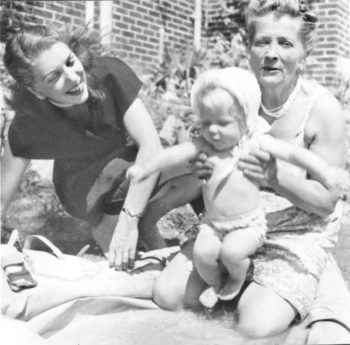
Gamps and my grandmother Lilian Melita Williams (Nanny to me) came to my rescue and I lived with them in Salisbury, Wiltshire until I was about 18 months old and my mother was well enough that I could return home. Most of the pictures from that time – gorgeous ones that I cherish – were taken by my talented Uncle Sven (my Aunt Jill’s husband). They visited me in Salisbury enough that I have a lovely album of a time I can’t recall, obviously being very well and lovingly taken care of.
Very sadly, Nanny took her own life in December 1961 when I was 7. I have only happy memories of her, but she struggled with bipolar disorder, so who knows how things would have evolved over time. I just feel very lucky to have had Gamps and Nanny take great care of me when I needed it.

